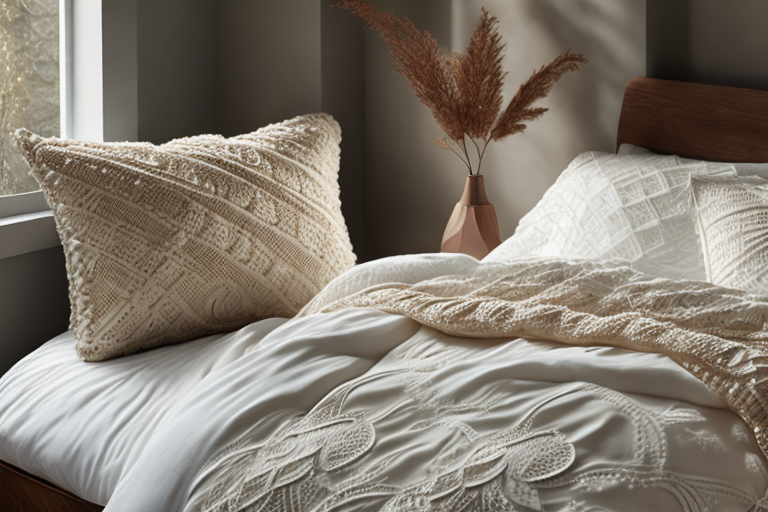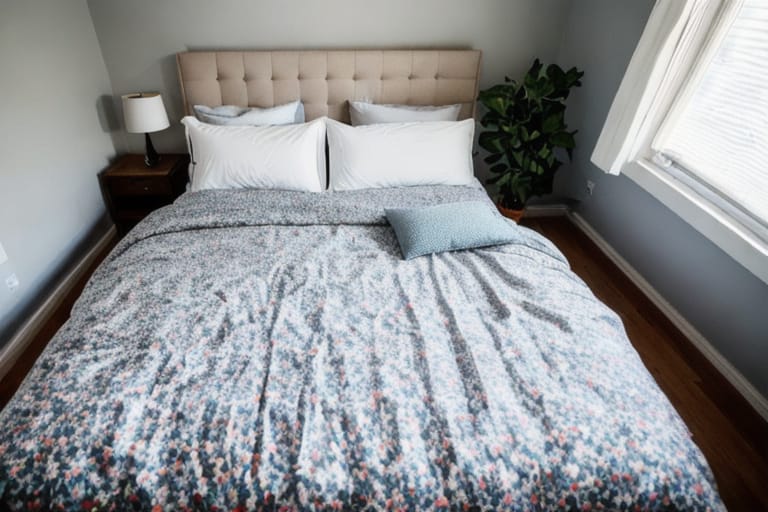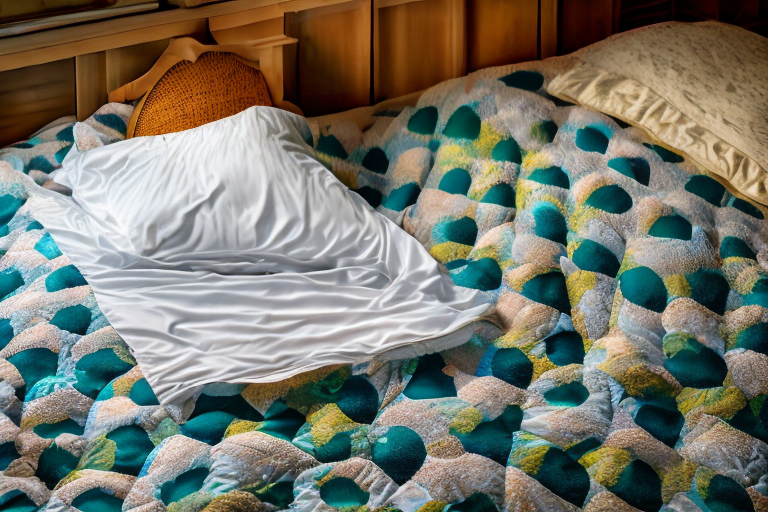Looking to purchase a warm, comfortable down duvet but not sure where to start? This comprehensive beginner’s guide tells you everything you need to know. We’ll compare different types of down duvets, key features to look for, pros and cons to consider, and tips for care and maintenance. Read on for the information you need to select the perfect down duvet!
What Exactly Is Down?
Before diving into down duvets, let’s review what down actually is. Down is the soft, fluffy cluster that sits underneath the tougher exterior feathers of ducks and geese. This natural insulator keeps birds warm by trapping air within its clusters.
Down clusters provide superior insulation with unrivaled softness and compressibility compared to synthetic alternatives. As a duvet filling, down is highly breathable, durable, and long-lasting.
The key properties that enable down to insulate so well include:
- Loft – Fluffiness and height when uncompressed
- Fill power – Volume of space one ounce of down takes up
- Resilience – Ability to spring back after being compressed
- Warmth-to-weight ratio – Less down provides more warmth
Now that you know what down is, let’s explore different types of down duvets…
Types of Down Duvets
There are a few key types of down duvets to consider:
Hungarian Goose Down
- High fill power – around 750+
- Large down clusters with excellent loft
- Light, breathable, and resilient
- Provides superior warmth for weight
European Down
- Typically goose or duck down
- Fill power around 600-700
- Very good durability and stability
- Quality insulation at moderate price point
Canadian Down
- Exclusively from Canadian geese
- Certifications ensure ethical sourcing
- Exceptional fill power – usually 600+
- Larger clusters than European down
Goose Down vs. Duck Down
What’s the difference between the two types of down?
- Warmth – Goose down has better warming performance with less filling
- Softness & Loft – Goose down clusters are generally larger and fluffier
- Durability – Duck down has slightly better durability over time
- Cost – Goose down is more expensive due to superior qualities
Both types make great duvet fillings with goose down having a slight edge in luxury and warmth.
Down Duvets and Allergies

Since down comes from birds, some worry it may aggravate allergies. But high-quality down itself is hypoallergenic as the protein allergens are washed away.
To minimize allergens like dust mites, look for duvets with:
- NOMITE® certification – Ensures 99% of dust mites eliminated
- Tightly-woven fabric casing – Typically 300+ thread count cotton
- Downproof barriers – Prevents leakage through casing
With proper construction and care, down duvets are quite suitable for allergy sufferers. Some may still react to airborne particles, in which case down alternatives can be considered.
Down & Feather Duvet Mix
Many duvets incorporate a deliberate mix of down and feathers. This blend balances the merits of both materials:
- Down provides unmatched warmth and softness
- Feathers add structure and support for fill distribution
- 80% down / 20% feather mix is common
- Premium “all down” duvets also available
Keep in mind:
- Higher down % = more expensive but warmer
- Higher feather % = heavier but improved durability
Choose your ideal blend based on warmth, weight, cost, and longevity preferences.
Ethical Sourcing & Certifications
There are some concerns around ethical treatment of birds during down harvesting. To ensure humane practices, look for certification programs like:
- Downmark Certification – Audits supply chain at every step
- Responsible Down Standard (RDS) – Animal welfare verified
- Down Association of Canada (DAC) – Strict production standards
- European Down & Feather Association (EDFA) – Code of practice for animal welfare
These respected organizations provide rigorous, independent auditing according to animal ethics codes and sustainability values. Their logos on duvets indicate cruelty-free, humanely-sourced down.
What Is Tog Rating?
Tog rating indicates a duvet’s thermal insulation – a measure of its warmth. It represents how much heat is retained within one square meter of duvet surface area:
- 4.5 tog = light warmth for summer
- 9 tog = medium all-season warmth
- 13.5+ tog = ideal for cold winter months
The exceptional insulating power of down means it provides substantial warmth at lower thicknesses than synthetic alternatives. This gives a lightweight, breathable feel perfect for temperature regulation.
Duvet Construction Quality
Beyond fill material, duvet construction dramatically impacts performance and feel:
- Outer casing – Typically woven cotton in 300+ thread count for durability, breathability and that coveted hotel bedding feel
- Internal barriers – Downproof layers prevent fill leakage and migration within the duvet
- Moisture-wicking – Pulls sweat away from the body, keeping you dry and comfortable
Well-made down duvets have reinforced double stitched edges and multiple secure layers protecting and stabilizing the delicate down filling while allowing it to fully expand and breathe.
Are Down Duvets Eco-Friendly?

As a natural material, down has some sustainability benefits:
- 100% biodegradable without releasing contaminants
- Outperforms synthetic fills so products last longer
- Recycled down initiatives give used down new life
However, certain processing and transportation in the down industry can have environmental impacts. Conscientious brands focus on localization and chemical-free production.
Overall down is a natural, renewable resource that – when sourced ethically – can certainly be an eco-friendly choice over synthetic bedding options which leach microplastics.
Down Duvet Alternatives
While unrivaled for warmth and comfort, down isn’t for everyone. Here are some alternative duvet fillings to consider with their own pros and cons:
| Filling | Pros | Cons | Price |
|---|---|---|---|
| Silk | Naturally moisture-wicking, breathable | Expensive, needs special care | $$$$ |
| Wool | Resilient, breathable, moisture-wicking | Can feel overly dense or warm | $$$ |
| Microfibre | Lightweight warmth, machine washable | Inferior insulation to down | $ |
| Down Alternatives | Mimic down feel at lower cost | Don’t match true down performance | $$ |
Down alternative fills made from synthetic materials like polyester are the most popular for shoppers wanting down properties without the price tag or animal usage concerns. Brands now engineer these with recycled fibers and components for sustainability as well.
Caring for Your Down Duvet
A quality down duvet will last over a decade when properly cared for. Key maintenance tips include:
- Spot clean small stains instead of full washing cycles
- Use gentle cycles in commercial machines when needed
- Natural line dry instead of machine drying
- Give duvet a good shake every so often to maintain loft
With some simple care, your investment will reward you with years of blissful comfort!
| Wash Settings | Dryer Settings | |
|---|---|---|
| Recommended | Gentle/Delicate Cycle | Tumble Dry Low |
| Best Practice | Professional Dry Cleaning | Line Dry |
Who Are Down Duvets Best Suited For?
While cozy for everyone, down duvets excel for:
Hot Sleepers
- Down’s breathability circulates air and moisture excellently for temperature regulation
- The lightweight feel prevents overheating better than flannel or polyester
Children’s Bedding
- Down’s softness provides comfort little ones love
- Allergen barriers reduce exposure to irritants like dust mites
- Easy to clean – just throw in the wash!
Those Wanting Hotel Luxury
- High-end down replicates 5-star quality at home
- Get the fluffy comfort and enveloping feel of a cloud
- Long-staple down offers durability matching top hotels
Innovations in Down Duvet Tech
Down duvet manufacturers keep innovating and improving with new findings around down sourcing, construction and sustainability:
Hybrid down blends combine down with wool, silk, cotton and other materials:
- Wool/down mix balances warmth, moisture-wicking and breathability
- Silk/down adds strength and sensorial luxury
Recycled down reclaims used down to reduce waste:
- Traceable supply chains verify proper collection
- Multi-stage purification rejuvenates loft, fill power
- Reduces environmental impact of production
As processing techniques and hybridized materials advance, down duvets continue getting better every year.
“We’re always researching the latest in down supply chains, materials science and sustainability models to create the perfect warmth-to-weight ratio for our customers with pieces that will last decades.”
– Down Duvets CEO Jane Lawrence
The Science Behind Down
What makes down such an incredibly effective insulator?
The fluffy filaments branching from the quill possess special properties that trap body heat. Under a microscope, down’s structure resembles a cluster of grapes – each with tiny fibrils sprouting in all directions.
This 3D structure is key – the filaments intercept still air within tiny chambers which slows heat loss. Heat builds within these spaces, keeping the exterior down layers warm which then retain more interior heat.
Down can compress tightly but always springs back to full loft when pressure releases due to its elasticity. As heat tries escaping from down clusters, the outer filaments catch the warmth and circulate it back internally.
This superior resilience, constant air circulation, and stable structure maintains an exceptional level of insulation not found in synthetic alternatives.
Down vs. Down Alternative: Which to Choose?
Should you choose natural down or synthetic down alternative? Here are key factors to weigh:
Warmth & Breathability
- Down wins for heat retention, moisture wicking and temperature regulation
Affordability & Convenience
- Down alternatives provide satisfactory feel and performance at lower price points and easy maintenance
Allergies
- Both perform well – down with certified duvets, down alt. inherently
Sustainability
- Down is compostable; down alt. is typically made of recycled plastics
Lifespan & Durability
- Down outlasts alternative fills but requires more care
For shoppers deciding between the two, choose down for unparalleled luxurious comfort and warmth or down alt. for budget-friendliness and convenience depending on your priorities.
Final Takeaways on Down Duvets
We’ve covered the different types, construction variables and compositional science behind down duvets. While an investment, quality down bedding pays dividends every night through decades of blissfully restful sleep.
When sourced ethically and cared for properly, down duvets provide unmatched comfort that keeps you cozy from head to toe – perfect for cold winter nights or hot sleepers alike. Alternatively those seeking budget beds or avoiding animal products can find satisfactory synthetic down alternatives on the market as well.
Hopefully this guide provides a helpful overview when selecting the ideal down or down alternative duvet for your needs. Sleep well and stay cozy!
Feel free to provide any feedback on the content, structure, length or other aspects of this article draft. I’m happy to incorporate edits and revisions as needed.
Frequently Asked Questions
Still have some lingering questions about down duvets? Here are answers to some common FAQs:
How often should I wash my down duvet?
Focus on spot cleaning when possible. Only do a full wash every 2-3 years, using a gentle cycle and proper drying methods to maintain fill power and loft.
What’s the best down duvet for summer?
Look for options with a lower tog rating around 4.5-7.5 for lightweight breathability. Hungarian goose down and eiderdown are perfect for warm weather.
Is a down duvet worth the money?
The unrivaled durability, longevity and luxurious comfort make a quality down duvet well worth the investment over cheaper synthetic alternatives that need replacing sooner.
How do I know if down is ethically sourced?
Look for certifications like Downmark, RDS or the Down Association of Canada to verify humane treatment and sustainability practices throughout the supply chain.
What’s better for allergies: down or down alt?
Properly-constructed down duvets with tightly-woven, downproof casings minimize dust mites and other allergens very well. Down alternatives also perform excellently for allergy sufferers.
Let me know if you need any other specific FAQs added or have feedback on the ones I included!








